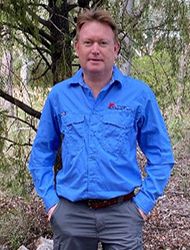Andrew Claridge

Dr Claridge joined VPRU in September 2019, having spent more than 20 years working as a wildlife biologist with the NSW National Parks and Wildlife Service. Prior to that he had professional appointments at the (then) CSIRO Division of Wildlife and Ecology and Australian National University in Canberra, having held an Australian Postdoctoral Fellowship bridged between the two organisations. He is also a previous recipient of a Fulbright Postdoctoral Fellowship, which saw him based at Oregon State University in the Pacific Northwest United States.
Commencing in the early 1990’s, Dr Claridge’s formative research examined interrelationships among wildlife, plants and mycorrhizal fungi. These interrelationships have been shown to offer resilience to forested and woodland landscapes, even during times of extreme stress such as after wildfires. From there, he has since led projects looking variously at: (i) the use of satellite tracking technology to explore landscape-scale movement patterns of wild dogs in relation to farming landscapes and conservation reserves; (ii) the non-target impacts of 1080, in relation to native predatory marsupials; (iii) the efficacy of fox control in restoring threatened native wildlife, and; (iv) environmental impacts of introduced deer in the Australian Alps. All of this research has led to practical outcomes for land management.
Dr Claridge is the southern NSW site leader for the NSW Feral Cat Project, focussed on examining ways to manage feral cats at landscape scales, and identifying benefits of control work on that invasive predator for native fauna. That project is principally funded through the NSW Environmental Trust and is a joint venture between the NSW Government and the University of New England. Within that team Dr Claridge collaborates closely with Drs Guy Ballard, Tarnya Cox, Bronwyn Fancourt and Paul Meek, together with other staff at DPI VPRU and the NSW National Parks and Wildlife Service. Major stakeholders in this project also include relevant regional Local Land Services, Forest Corporation of NSW and private landholders and organisations.
Outside of the feral cat project Dr Claridge continues to work on developing optimal monitoring practices for measuring success of invasive species management programs – a topic shared collaboratively among the staff at VPRU. These projects are funded through state government initiatives such as the Saving Our Species Program and involve collaborations with staff across other parts of DPIE. Alongside these research endeavours he is also closely involved in threatened species monitoring programs across the State, including work on the spotted-tailed quoll, which sits at the intersection of operational programs aimed at minimising predation on domestic stock by wild dogs.
Anchor Section List
Explore
Research Interests
Featured Projects
DisplayingNon-target impacts of 1080 baiting for canids, with special emphasis on the spotted-tailed quoll (2016–present)
Non-target impacts of 1080 baiting for canids, with special emphasis on the spotted-tailed quoll (2016–present)
Distribution and ecological impacts of introduced deer in the Australian Alps (2015–present)
Distribution and ecological impacts of introduced deer in the Australian Alps (2015–present)
Examining methods to manage feral cats and monitoring the response of native fauna to their control (2019–present)
Examining methods to manage feral cats and monitoring the response of native fauna to their control (2019–present)
Using camera traps to monitor native fauna more effectively, including mammals and herpetofauna (2016–present)
Using camera traps to monitor native fauna more effectively, including mammals and herpetofauna (2016–present)
Monitoring the response of native ground-dwelling mammals to intensive fox control (2015–present)
Monitoring the response of native ground-dwelling mammals to intensive fox control (2015–present)
Recent Publications
Displaying
Camera-traps are a cost-effective method for surveying terrestrial squamates: a comparison with artificial refuges and pitfall traps
PLoS ONE 15(1): e0226913. https://doi.org/10.1371/journal.pone.0226913.

Improving terrestrial squamate surveys with camera-trap programming and hardware modifications
Animals 9: http://dx.doi.org/10.3390/ani9060388

Elucidating patterns in the occurrence of threatened ground-dwelling marsupials using camera-traps
Animals 9: http://dx.doi.org/10.3390/ani9110913

Redundancy among mammalian fungal dispersers and the importance of declining specialists
Fungal Ecology 27: 1-13. http://dx.doi.org/10.1016/j.funeco.2017.02.005

A frontier in the use of camera traps: surveying terrestrial squamate assemblages
Remote Sensing in Ecology and Conservation 3: 133-145. http://dx.doi.org/10.1002/rse2.57

Data on the fungal species consumed by mammal species in Australia
Data in Brief 12: 251-260. http://dx.doi.org/10.1016/j.dib.2017.03.053

Introduced Deer: Field Identification Guide For The Australian Alps. Office of Environment & Heritage
NSW National Parks & Wildlife Service, Queanbeyan, New South Wales. 45 pp.
Professional Associations and Activities
Contact
Email: andrew.claridge@dpi.nsw.gov.au
Research branch: Climate and Water Research, Climate, Water, Soil and Forests, Environmental Sustainability
Location: Queanbeyan